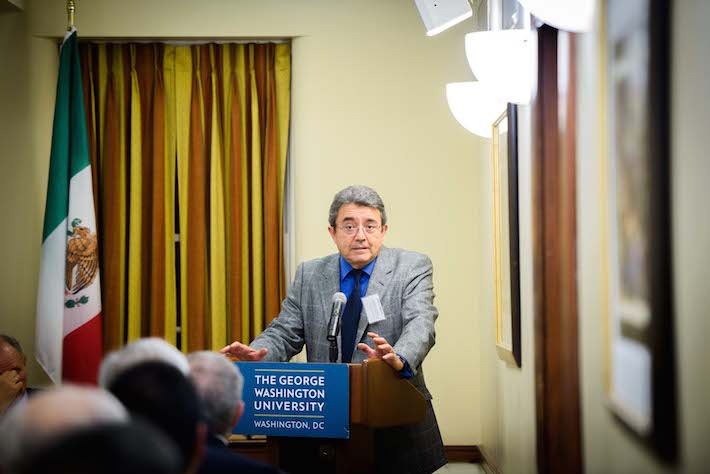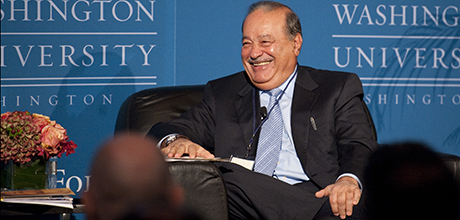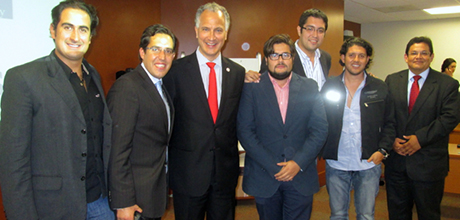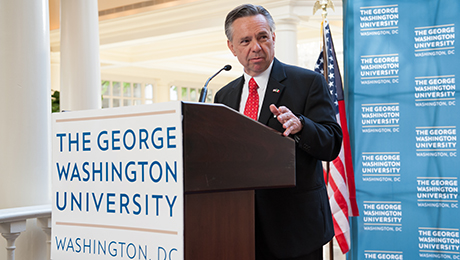By James Irwin
The first constitution written in Mexico—a document drafted more than 200 years ago and never implemented—had elemental ties to similar governing instruments of the era and served as a reference for republican ideas in the country well after it was replaced, according to experts convened Monday at the George Washington University.
The Constitution of Apatzingán, drafted Oct. 22, 1814, demonstrates that Mexico (then New Spain) was part of an era of history known as the constitutional revolution, said Catherine Jane Andrews, associate professor in the history department at the Centro de Investigaciones y Docencias Económicas, A.C. (Center for Economic Research and Teaching).
Speaking at an event commemorating the 200th anniversary of the document, Dr. Andrews and Ambassador Emilio Rabasa, permanent representative of Mexico to the Organization of American States, touched on its historical significance at an event hosted by International Advancement within the Division of Development and Alumni Relations, the Mexican Students Association and the Mexican Mission to the OAS.
“I don’t think this is as well known in this country as Cinco de Mayo or our independence day, but the Constitution of Apatzingán is something to think about, especially at such a prestigious university as this one,” Amb. Rabasa said.
 Though it never was implemented, the Constitution of Apatzingán is recognized as the first constitution written in Mexico (then New Spain), said Catherine Jane Andrews, associate professor in the history department at the Centro de Investigaciones y Docencias Económicas, A.C. (Center for Economic Research and Teaching).
Though it never was implemented, the Constitution of Apatzingán is recognized as the first constitution written in Mexico (then New Spain), said Catherine Jane Andrews, associate professor in the history department at the Centro de Investigaciones y Docencias Económicas, A.C. (Center for Economic Research and Teaching).
The Constitution of Apatzingán came out of the Congress of Chilpancingo and followed Mexico’s 1813 declaration of independence from Spain. The document contained 242 articles and established a tripartite, republican form of government with a three-man executive and separate departments for war, finance and administration. Issued during the leadership of the insurgent army of José María Morelos—a revolutionary priest who led Mexico’s independence movement from 1810 to 1815—the constitution created a weak central executive and vested almost all power in the legislative branch.
“This is done deliberately to avoid having a president,” Dr. Andrews said. “The deputies [of the Congress of Chilpancingo] feared that one president could become a despot. They are very much aware of Napoleon, they are very much aware of [the Spanish monarch] Ferdinand. The great fear in Mexico is the fear of the despot. Why are they so scared of a strong executive power? It’s because they don't want Morelos telling them what to do.”
The constitution was never implemented as the independence movement was crushed in a series of military defeats in 1815—the final of which culminated in Morelos’ execution. But the document offered an alternative, indigenous constitutional arrangement to the one put forward in the Constitution of Cadiz (the 1812 Spanish Constitution drafted during the era of Napoleon’s invasion during the Peninsular War). It also demonstrated that the deputies of the Chilpancingo Congress were familiar with similar documents of the era, Dr. Andrews said.
“There is evidence they were aware of quite a few publications from the United States and of constitutional documents in France,” she said. “This is very important. It shows you that New Spain was part of the constitutional revolution. It didn’t just participate by copying the U.S. It certainly didn’t copy France. They stated the examples they knew of, discussed them in light of the context they were in and drew up a constitution.”
 Joel Gomez, associate professor of educational leadership in the Graduate School of Education and Human Development, and Francisco Gaona, president of the Mexican Students Association, share a moment during Monday night's event. "For the [Constitution of Apatzingán] to never be implemented is sad," Mr. Gaona said. "But it was the foundation of other constitutions applied in Mexico. It’s interesting to know the original document comes all the way from the Mexican Revolutionary War."
Joel Gomez, associate professor of educational leadership in the Graduate School of Education and Human Development, and Francisco Gaona, president of the Mexican Students Association, share a moment during Monday night's event. "For the [Constitution of Apatzingán] to never be implemented is sad," Mr. Gaona said. "But it was the foundation of other constitutions applied in Mexico. It’s interesting to know the original document comes all the way from the Mexican Revolutionary War."
Monday's event is one of several hosted over the past few months by the Mexican Students Association and International Advancement, and also featured remarks from Joel Gomez, associate professor of educational leadership in the Graduate School of Education and Human Development and Leticia Bonifaz, professor, researcher and head of the legal department of CIDE. The Mexican Students Association and International Advancement held a reception in May featuring remarks from GW Provost Steven Lerman and Mexican Ambassador to the United States Eduardo Medina Mora that focused on increased international student recruitment from Mexico.
There are more than 100 current students from Latin America studying at GW. More than 50 are from Mexico.
“The United States currently is the second-largest Spanish-speaking country in the world,” Dr. Gomez said. “We share histories, we share cultures, we share an economy and we share people.”
Though the Constitution of Apatzingán was never implemented as a governing document, it is recognized as the first constitution drafted in Mexico. Subsequent constitutions establishing federal republics were enacted in 1824 and 1857, respectively. Mexico’s current constitution has been in effect since 1917.
“Mexico has had four constitutions. It’s really important for us to know and understand the first one,” said Francisco Gaona, president of the Mexican Students Association. “If you look at the historical context, it was pretty rare then to have a republic—in most of the world you had monarchies and constitutional monarchies. For Mexico to think about a republic is pretty interesting. And even though they had influence from abroad, this was a Mexican document. It’s ours.”





